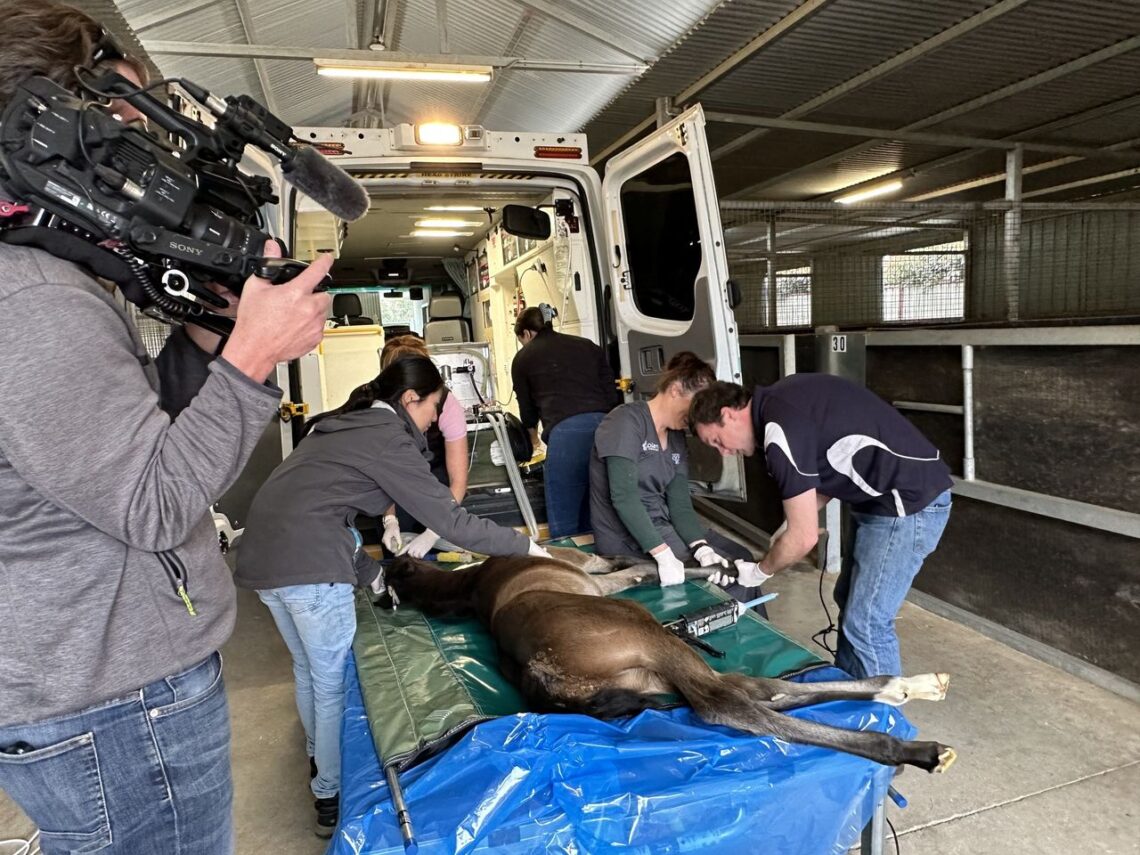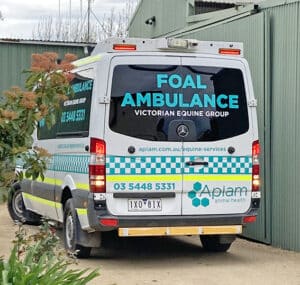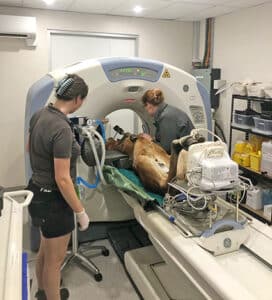
For the love of foals
The team at Bendigo Equine Hospital have created quite a stir with their innovative foal ambulance. AMANDA MAC spoke to Dr Mike Whiteford to learn more.
Foals, and who among us doesn’t love them, can be surprisingly fragile creatures. Hopefully, they will frolic through their early lives without a problem, but when something does go wrong, it can go quite wrong and surprisingly quickly. And if that foal happens to be a Thoroughbred destined for the racetrack, hundreds of thousands of dollars may be at stake, let alone the even greater importance of the foal’s wellbeing.
The Victorian Equine Groups’ Bendigo Equine Hospital, led by senior veterinarian Dr Sarah Jalim, is home to a team of specialist equine vets and nurses. Located in a region renowned for some of the nation’s top Thoroughbred studs, the hospital is always busy, and at no time more so than foaling season.

But the care and treatment of foals can come with its own unique set of challenges, which is why the hospital’s innovative foal ambulance is such a significant game changer.
The ambulance, the subject of a recent ABC TV Landline story, is, at the time of writing, one of a kind – it’s a great idea born out of necessity, as so many of the best ideas are. Dr Mike Whiteford, one of the hospital’s equine veterinarians explains: “Last year we were offered the use of a CT scanner located at a practice only a few kilometres from our hospital. We see a lot of neonatal foals with various musculoskeletal injuries, infections, dummy foals and so on, and because a CT scanner is 3D rather than 2D, it’s a far better diagnostic tool when compared to an x-ray. Having access to the scanner elevates everything. It’s more in line with human medicine in terms of the diagnosis we can reach.”
The use of the scanner was a generous offer that the hospital staff were keen to take advantage of, but there was a logistical problem: the scanner belonged to a small animal practice that didn’t have the facilities to accommodate a mare while her foal was scanned. “So we thought the most sensible approach would be to take the foal there on their own,” Mike says. “We were firing around a few different ideas as to how we could do that when we thought that probably the safest way to transport a foal would be under anaesthetic in an ambulance.”
Although the team wasn’t entirely sure their idea of a foal ambulance was going to work, they decided to give it a try anyway. When ambulances for humans are decommissioned, they’re sold in online auctions. The hospital bought one sight unseen and Mike collected it from Melbourne. “They’re stripped of all the exterior signage, but the internal workings are still there: the oxygen tank fittings, the lights, the extractor fans. None of us here at the hospital are particularly mechanically minded, so we sort of took a leap of faith,” he laughs.
The next step was to work out how to get a foal safely on and off-board the ambulance. “The collapsible trolley used by paramedics to load human patients into an ambulance didn’t come with it. So we borrowed and repurposed various components and a local guy, who’s handy with a welder, made up a frame to use with a bed that’s suitable for foals,” Mike explains. “We also designed the bed to be dual purpose; it folds out so we can use it as a surgical table as well.”

Compromised or sick foals deemed to be good candidates for a CT scan are generally, along with their mothers, inpatients at the hospital. Once the team decide a scan is required, the foal is anaesthetised in a purpose-built padded room and the mare is heavily sedated to prevent her fretting. The foal is then loaded into the ambulance, and kept asleep during the drive (using the on-board anaesthetic equipment), the scan, and the return trip. “We monitor them carefully and bring them back to the hospital’s padded recovery room where the foal wakes up as if nothing has happened,” Mike says.
As work on the project progressed, the team recognised another of the ambulance’s benefits. “We realised we would be able to offer a much safer and more controlled anaesthesia on-farm, using the anaesthetic machine we’d bought for the ambulance. It was actually an ex-army machine that would have been used on the battlefield, but it allows us to use gas anaesthesia, which is what doesn’t happen when you do on-farm surgeries.”
Usually, on-farm surgeries are performed when the patient is anesthetised intravenously, but it’s much safer for a foal to be put under with a mix of gas and oxygen. “We can change the depths of anaesthesia very easily with the gas. It’s effectively the same system as you would have in any normal hospital or in our equine hospital,” Mike says. “Horses are a fight or flight animal, they’re not designed to go to sleep so making anaesthesia safer is very important to us,” he adds.
Besides the anaesthetic machine and oxygen bottles, the ambulance is also equipped with an ECG monitor, blood pressure monitor, and SpO2 (Saturation of Peripheral Oxygen) monitor – everything needed to ensure the foal’s vital signs are safely within normal range while they’re under the anaesthetic.

Much of the team’s on-farm work involves corrective surgeries on lower limbs, so the ambulance’s on-board x-ray machine is going to be a real bonus. “Foals are often born with wonky legs,” Mike explains, “and we spend a lot of time trying to get those legs straight so there’re no repercussions down the line in terms of arthritis and strain on joints. We place titanium screws across growth plates which allows us to manipulate the way the leg grows as the foal grows, so hopefully we can end up with a nice, straight leg.”
Essentially, the ambulance is a mobile surgical suite and if they’re attending an on-farm surgery, the team consists of a minimum of three people, including the surgeon, an anaesthetist and a nurse.
While the foal ambulance is in its early days and has so far been used on only a handful of occasions, the concept has been very successful. “We were all a little bit on edge that it wouldn’t work, but we’ve had several foals scanned and got some really nice images – and as the season goes on, we’ll be doing a lot more on-farm surgeries.”
Maximising the potential of the foal ambulance will take time and fine-tuning. “It’s like anything,” Mike says, “the more we do this the slicker we get. There are a lot of moving parts, a lot of different people involved, and there’s the foal who’s asleep under anaesthesia. We’ve got to be really alert and be careful to dot our i’s, cross our t’s, and make sure that everyone’s on board with what’s happening. As time goes on and we iron out those systems they will, I think, become second nature.”
The team’s priority is for the ambulance to be of benefit to the breeders and stud farms in the area they service. “That’s hopefully where it will come into its own, just offering that next level of service and safety, because we’re dealing with foals that are potentially worth a lot of money.”
Other equine hospitals have been quick to offer positive feedback. “They’ve been saying that they think it’s a really good idea and they’d like one. So, this will be a test case, and if it goes well, we might build a few more,” Mike adds.
For more information, visit the Victoria Equine Group, or follow them on Facebook.



